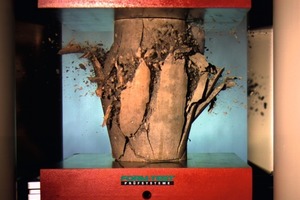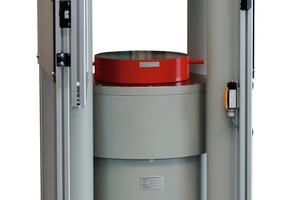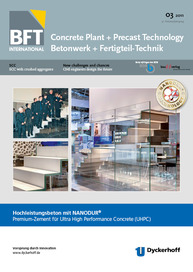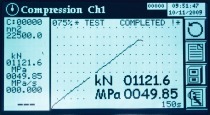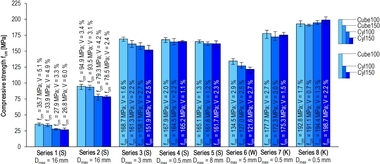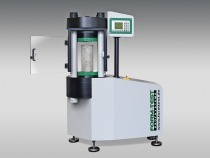Tests for high-strength and high-performance concrete
According to the usual definitions high-strength concretes as such are distinguished by a compressive strength > 65 N/mm² and high-performance concretes as such by a high degree of tightness, resistance to physical or chemical impacts, strength and self-compaction. Using the raw materials and processing methods common in practice it is already possible to realize building components with compressive strengths of about 150 N/mm².
Mortar and concretes with a compressive strength of up to 800 N/mm² are currently under development. Typical fields of application of high-strength concrete and high-performance concrete are:
» components subject to compression loading (e.g.: columns and walls)
» components subject to high mechanical and environmental load (e.g.: tunnels, industrial floors, road construction parts and offshore structures)
» components subject to high chemical load (e.g.: cooling towers, agricultural components with protection against fermentation and fodder acids)
» composite structures (e.g.: steel coated columns)
» special constructions (e.g.: bank vaults, screw piles)
Therefore, both concrete types, high-strength concretes and high-performance concretes, make very high demands on personnel and equipment concerning manufacturing and processing, surveillance and quality assurance and in particular in terms of compressive strength testing.
Compressive strength testing
The compressive strength is the most important property of concrete. This is used as reference unit for the classification of concrete. For historical reasons but also for the sake of better handling the compressive strength is determined with the aid of cubes and cylinders.
In Germany and Europe for testing purposes concrete cylinders measuring 150 mm in diameter x 300 mm in height and/or concrete cubes with an edge length of 150 x 150 mm after storage are used according to EN 12390-2. The test specimens have to comply with the requirements of EN 12390-1. At the beginning, at least 3 specimens have to be tested from different ready-mix trucks for a maximum of 50 m³ concrete placed per day. According to EN 12390-4 compression testing machines of at least of quality class 2 in compliance with DIN 51220 / EN 7500-1 are required as testing device. It is however highly recommended to use servo-hydraulic testing machines with adjustable rupture recognition of quality class 1.
In the past, many owners of an „old“ compression testing machines, in particular such with testing frames made of a welded constructions, two-column testing frames but also four-column testing frames with screwed nuts, badly damaged and even partly entirely destroyed their testing frames when testing specimen cylinders and cubes of high-strength concrete.
Form + Test Prüfsysteme located in the Swabian city of Riedlingen have carried out extensive studies and tests with high-strength specimen cylinders with a diameter of 150 x 300 mm with various compression testing frames and have documented these test series by means of a high-speed camera with image sequences of 2500 / 3750 and 10000 images per second. These tests confirmed in practice and quite comprehensible for all users the theoretical assumptions and calculations of the development department. The result of this are compression testing machine frames and/or auxiliary equipment for compression testing frames that were especially developed for the testing of high-strength and high-performance concrete. Among others, there is the testing frame that was designed as a four-column model with an extremely high degree of torsional stiffness and the least possible expansion applying maximum test load. The bottom pressure plate of this model is screwed with the piston through clamping elements. The pendulum axles or also called „Kalotte“ is made of special steel as reinforced version in an especially optimized production process. Insulating material at the machine frame provides for best possible stroke absorption.
For load measurement there is a precision liquid pressure transducer with overload protection and recoil throttling. The guard door of the shatter protection is locked by a closable door limit switch. As to realize the fast reaction times required for precise and consistent measured values a very fast reacting servo valve is used. The further developed digital control system DigiMaxx® provides for the high test frequency (sampling rate). Special software is available for measurement logging and data storage as well as for evaluation and issuing of test reports. Further applications are displacement and/or deformation control. It goes without saying that these compression testing machines can also be used for testing the compressive strength of concrete specimens according to EN 12390-3 (compressive strength) and the elasticity module.

